Dianthus gratianopolitanus
Highly evocative of cottage and rock gardens, Cheddar pinks, Dianthus gratianopolitanus, are members of the carnation family, with delightful, fringed flowers and a spicy fragrance of sweet cloves.
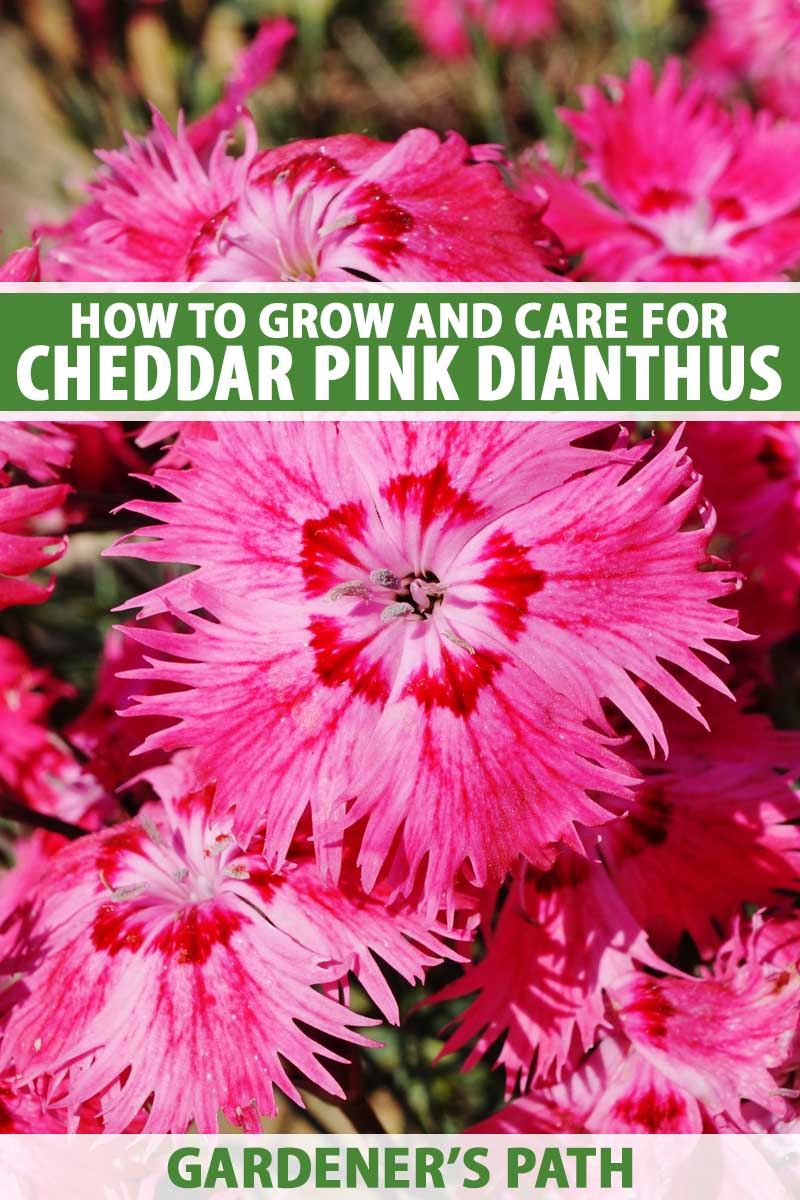
We link to vendors to help you find relevant products. If you buy from one of our links, we may earn a commission.
Small flowers in luscious shades of mauve, pink, and raspberry red form clouds of color, rising on wiry, branched stems from cushions of pretty, steel blue foliage.
These compact plants have a long, impressive flowering season, first with a heavy floral display in late spring and early summer, then with a lighter rebloom in late summer if spent flowers are deadheaded.
Charming, evergreen perennials, they’re also tough and hardy, with good resistance to cold, drought, heat, and humidity.
Easy to care for, they’re among the most fragrant of Dianthus species and generous with their rich perfume of honey and cloves that fills the surrounding air.
A delightful addition to raised beds, border fronts, edging, and containers, they also make an excellent small-space ground cover.
But they really shine in rocky environments such as rock gardens, tucked into pockets and crevices on stone walls, or spilling over the edge of retaining walls.
And they attract helpful pollinators like bees, birds, and butterflies to the garden, but are deer resistant.
If you like your plants easily cultivated with scrumptious colors over a long season and an intense fragrance, join us now for a look at how to grow Cheddar pinks!
Here’s what’s ahead:
What You’ll Learn
What Are Cheddar Pinks?
Also commonly known as cliff, clove, or Grenoble pinks, Cheddar pinks are members of the Caryophyllaceae family, which also includes carnations.
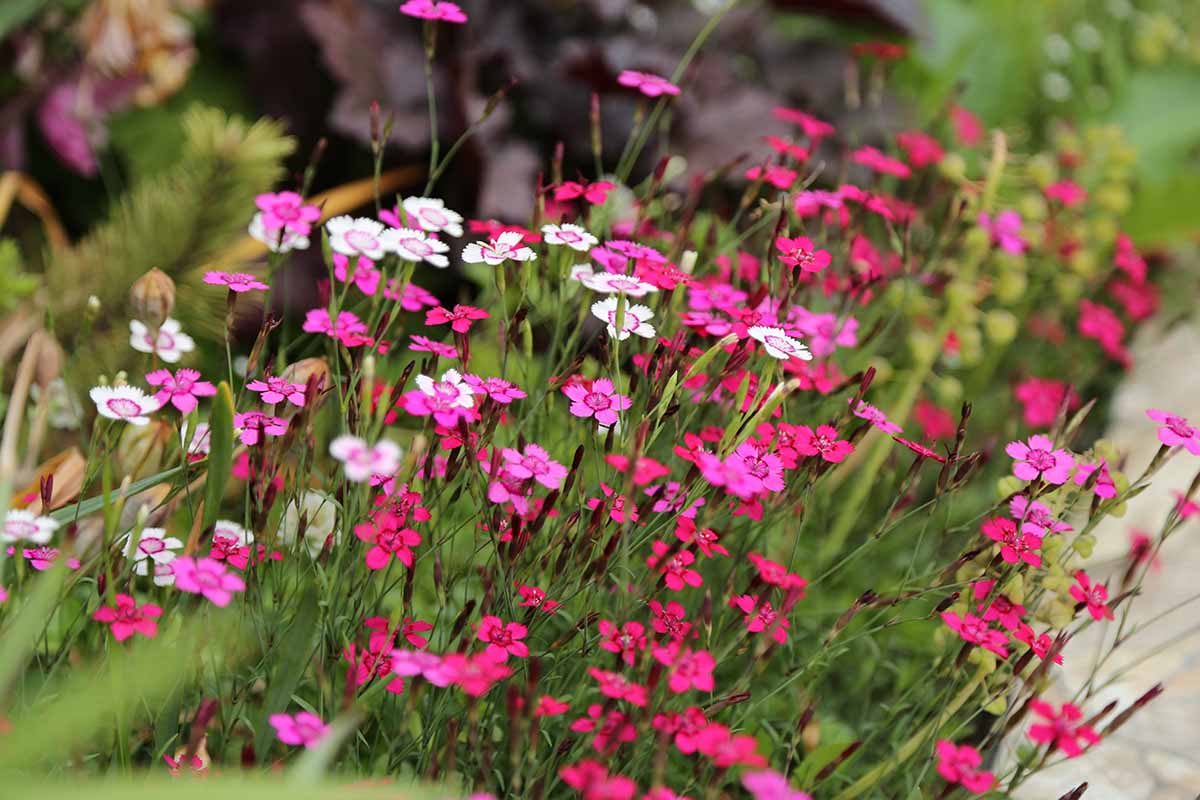
Herbaceous perennials, the evergreen plants spread laterally and form cushions or mats of foliage that grow to a height of six to 12 inches with a similar spread.
Single or double-petaled flowers have deeply fringed margins and are colored in shades of fuchsia, mauve, pink, raspberry, salmon, and white.
The flowers are most abundant in May and June, forming magic carpets of bold color. Plants rebloom lightly in late summer if the spent flowers are promptly deadheaded.
Rich in essential oils like eugenol, they have an intense, spicy fragrance of cloves with notes of sweet honey, perfuming the air throughout the garden.
Among the longer-living species of dianthus, D. gratianopolitanus is cold tolerant and tough, easily withstanding frost and cold temperatures, with good heat and humidity tolerance as well.
Plants are also salt tolerant and make a good choice for seaside gardens or roadside beds that are subjected to salty snow from passing plows.
Hardy in USDA Zones 4 to 8, many cultivars, like ‘Firewitch,’ are suitable for growing in a broader range of climates in Zones 3 to 9.
Cultivation and History
Cheddar pinks are native to central and western Europe, from the UK to Ukraine, where they typically grow in open grasslands, along mountain slopes, and in pockets of rocky outcrops.
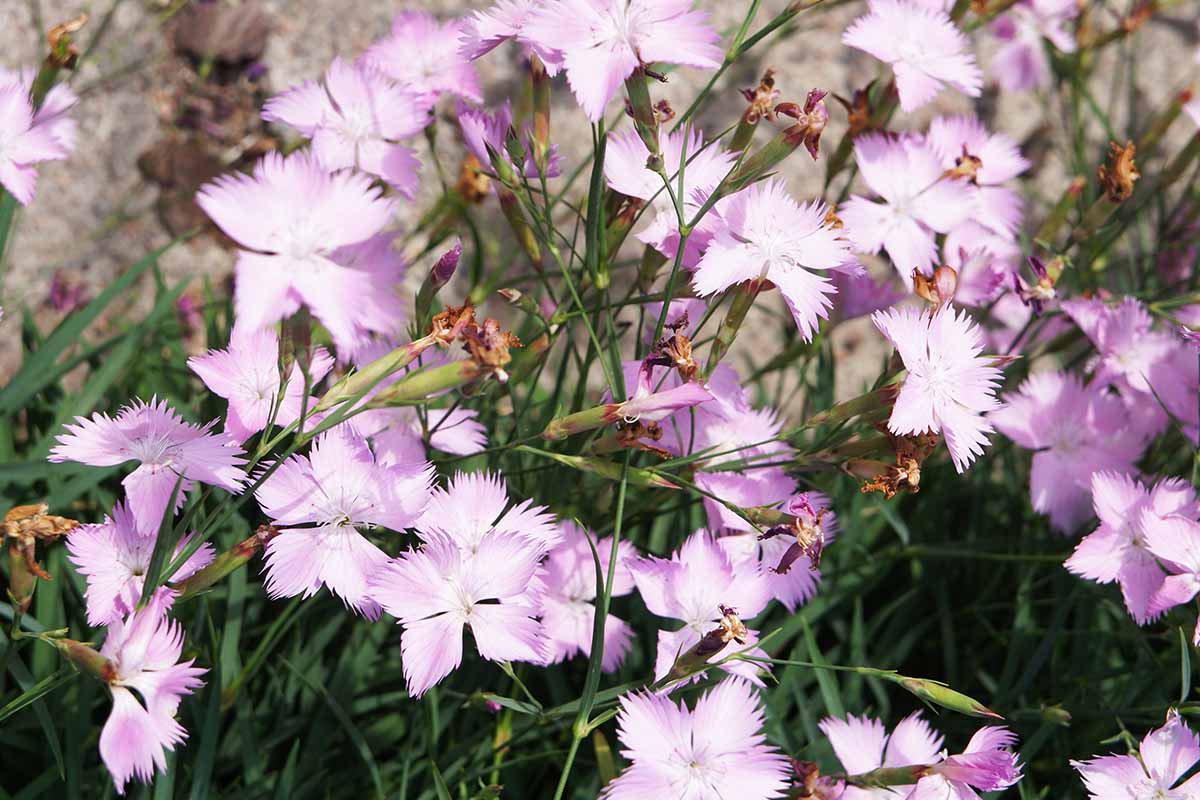
The common name refers to their native environment in the Cheddar Gorge in England, where they grow along limestone cliffs.
And the specific epithet, gratianopolitanus, refers to the ancient Roman name for the French city Grenoble, where botanist Dominic Villars first documented their growth in the late 1700s.
Their natural habitat includes environments with extreme conditions of cold, drought, erosion, and heat, resulting in compact plants that are as tough as they are pretty.
Throughout Europe, they’re considered endangered or vulnerable, and have been given protected status in many countries including England.
An outstanding performer, D. gratianopolitanus was granted the prestigious Royal Horticultural Society (RHS) Award of Garden Merit.
Propagation
Perennial Dianthus species like Cheddar pinks are propagated by division, seeds, and tip cuttings.
Division
Plants can be divided in spring every three or four years, or when the center begins to die out.
If the soil is dry, water plants thoroughly a day or two before division to make lifting easier.
Fully insert a spade four to six inches past the greenery and all around the plant’s perimeter. Pry up gently and remove from the ground.
Use a clean, sharp knife or garden saw to cut root balls into equally sized sections, like halves or quarters. Use your fingers to loosen the soil of each section, then shake gently to remove excess soil.
Replant promptly to the same depth as the parent plant and water gently.
Seeds
Seeds from species plants can be started indoors or outdoors, and you can find details for both methods in our guide to growing sweet william.
But remember, seeds obtained from hybrids may not grow true to the parent plant.
Tip Cuttings
Tip cuttings are taken in summer after the main flush of flowers have finished blooming.
Choose cuttings from stem tips that measure about two to three inches in length, cutting just above a leaf node. Strip away the lower leaves and place stems in a jar of warm water to soak overnight.
The following day, remove tips from the water and dip cut ends into a rooting hormone.
Fill small pots measuring four to six inches with a moist, porous potting mix. Gently insert the stems into the soil and firm in place, placing three to four equally spaced cuttings in each pot.
Place the pots in a location indoors with bright, indirect sunshine, or find a spot in the garden with dappled sunlight or light shade.
Keep the soil moist and roots will form in three to four weeks. After roots are well-established, transfer to larger pots or into the garden.
Tip cuttings taken in summer flower the following year.
How to Grow
Cheddar pinks require a full sun location and do best in slightly alkaline to slightly acidic soils with a pH of 6.0 to 7.5. Provide light afternoon shade in areas of extreme heat.
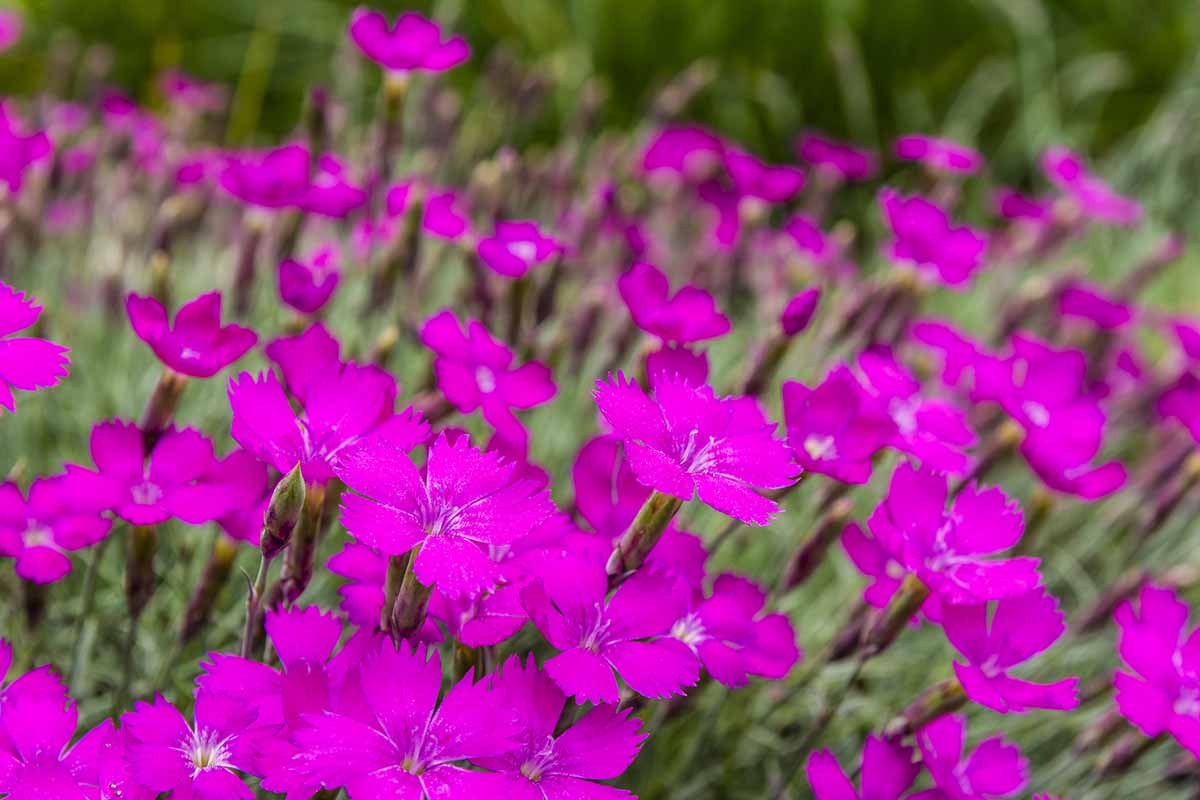
They’re adaptable to lean soils but give the best floral displays when planted in humus-rich, well-draining soil with a porous or lightly gritty texture.
If needed, amend the soil by digging in two to four inches of organic matter such as compost or well-rotted manure to a depth of six to eight inches.
And because plants are subject to root rot in poorly draining soil, adding a shovelful or two of landscape sand or pea gravel into the mix is recommended. Planting in raised mounds is another way to ensure good drainage.
When planting, mix in some bone meal to aid healthy root growth, and set crowns at or slightly above soil level. Allow 12 inches of space between plants.
Firm the soil lightly and water gently. Provide about one inch of water per week, allowing the soil to dry between watering.
In areas with moderate to high rainfall, avoid the use of heavy mulches in winter and opt for pea gravel instead – this helps to keep the foliage clean and the crown area well-drained.
Flowering in late spring to early summer, seeds ripen in late summer and can be allowed to self-sow or collected from species plants in late July and August.
Collect seeds just as pods open, or bend the stems and shake out the seeds to cultivate in place.
For container growth, place in a full sun location with well-draining soil amended with moisture-retentive materials such as coconut coir, peat moss, perlite, or vermiculite.
Water regularly, allowing the soil to dry slightly between waterings, and fertilize monthly with a balanced, all-purpose fertilizer.
Growing Tips
- Plant in well-draining soil to prevent fungal problems like crown rot.
- Avoid heavy mulches like compost and use a porous layer of pea gravel instead to keep the soil around the crown and roots draining freely.
- Once established, Cheddar pinks are drought tolerant for short periods, but require some water in extended dry spells.
Pruning and Maintenance
Maintenance for these showy ornamentals is straightforward as well.
D. gratianopolitanus spreads laterally and forms lovely mats or cushions of blue-green foliage. However, these are short-lived perennials and benefit from root division every three or four years, or when the centers begin to die back.
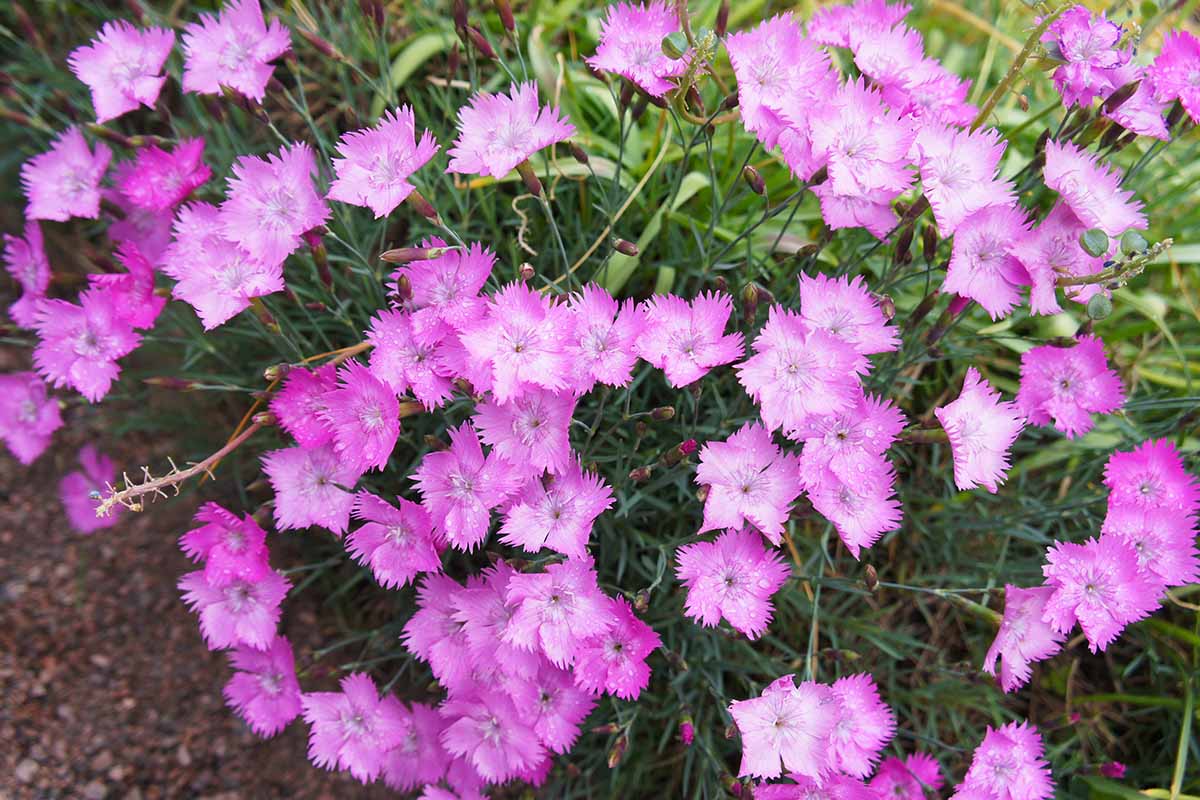
Light feeders, they don’t require much fertilizer. After new growth appears in spring, apply a balanced, slow-release fertilizer, or use a water soluble, all-purpose fertilizer after flowering.
However, container plants require more frequent nutrient replenishment and can be fed every four to six weeks during the growing season with an all-purpose fertilizer.
Deadhead or shear plants after flowering to encourage sporadic reblooming.
Prepare plants for winter by cleaning away debris from the soil surface and remove any brown or damaged foliage.
Cheddar pinks are very fussy about drainage and can’t abide wet roots or standing water, particularly in winter. If a winter mulch is needed for cold protection, choose a free-flowing material such as pea gravel and avoid the use of heavy, moisture-trapping materials like compost.
Place containers in a sheltered spot to overwinter. In areas with high winter rainfall, remove saucers from under pots to ensure the roots are not in standing water.
Cultivars to Select
You can typically find species D. gratianopolitanus seeds and live plants at your local plant nursery or garden center, or you can pick them up online.
Heritage seeds are available at Walmart.
In addition to the species plant, there are many popular D. gratianopolitanus cultivars to choose from.
Here’s a small sampling to whet your appetite:
Bath’s Pink
Fringed and highly fragrant, ‘Bath’s Pink’ is beloved for its masses of soft, pale pink flowers with a magenta eye and dainty, fringed margins.
The handsome blue-gray foliage is attractive year-round and remains evergreen in all but the coldest climates, forming attractive, compact mats that spread up to six inches.
‘Bath’s Pink’ is an excellent choice for borders, containers, edging, and cottage or rock gardens. Hardy in Zones 3 to 8.
Container plants are available at Nature Hills Nursery.
Firewitch
A highly popular hybrid, ‘Firewitch’ features a profusion of magenta pink flowers with a rosy eye and deeply fringed margins.
The low-growing plants reach a height of six to nine inches. Hardy in Zones 3 to 9.
Container plants are available at Burpee.
Read more about growing this gorgeous cultivar in our guide.
Tiny Rubies
Loaded with fringed and ruffled double blooms, ‘Tiny Rubies’ is a dwarf variety that grows four to five inches tall, and creates beautiful mats of rosy pink flowers.
An excellent choice for borders, containers, edging, rockeries, and flanking entryways, paths, and walkways.
The relatively long-stemmed flowers are excellent for cutting as well. ‘Tiny Rubies’ is hardy in Zones 3 to 9.
Container plants are available at Nature Hills Nursery.
Managing Pests and Disease
Many of today’s hybrids are bred for improved disease resistance, but there are still a few common issues to be aware of.
Sap-sucking pests such as aphids or spider mites make the occasional appearance but can be easily eliminated with a strong spray of water from the garden hose.
For more persistent infestations, use a pesticide with natural ingredients to repel insects and prevent them from laying eggs.
Garlic Barrier is a suitable option that’s available at Arbico Organics.
Garlic Barrier Insect Repellent
Alternatively you can make your own garlic spray following the instructions in our guide.
Slugs and snails can also be a nuisance, particularly in shady spots.
If possible, give plants a full sun location or use a mulch of sharp gravel or diatomaceous earth to repel these pests. You can find more gastropod solutions in our guide to protect your garden from slugs and snails.
Pinks are also susceptible to crown rot, especially in cool, wet conditions. To prevent rot, provide plants with well-draining soil and ensure crowns are planted at the soil level or slightly above.
Rust can also appear, most notably in wet or hot and humid conditions. Help to prevent the appearance of rust with well-draining soil and ample air circulation between plants.
Best Uses
These cushion-forming evergreens have a variety of applications in the garden.
They make a fragrant addition to raised beds, borders, and containers like patio pots and window boxes.
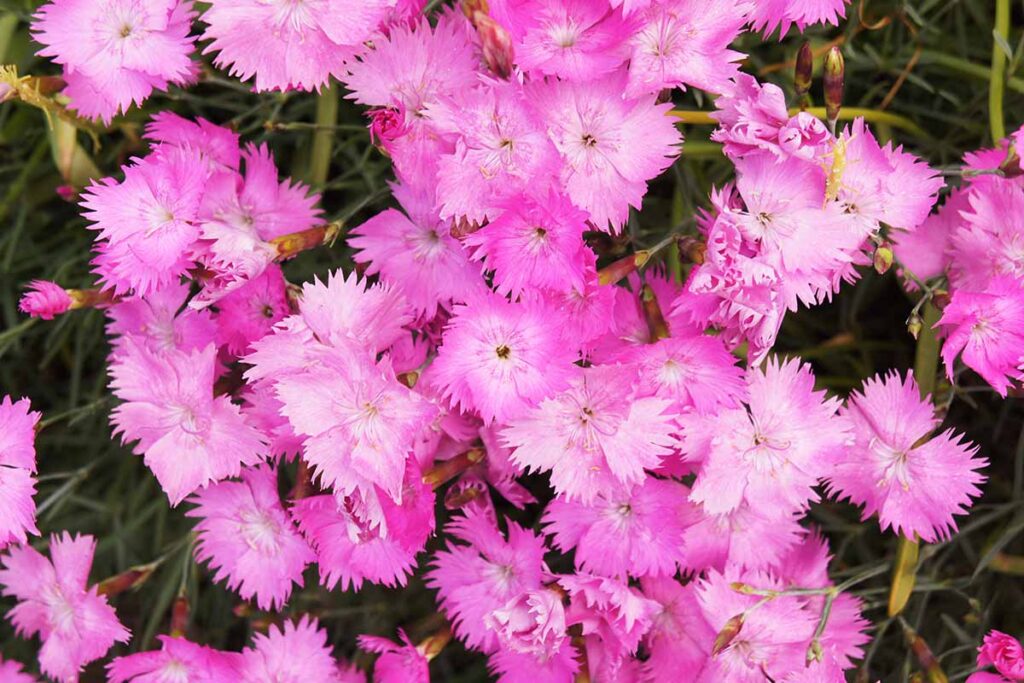
They’re also an excellent ground cover in small areas or sunny slopes and are simply stunning in rockeries, rock wall crevices, or spilling over the top of retaining walls.
Cheddar pinks are equally at home in themed settings such as butterfly, cottage, and cutting gardens, adding fragrance and a long season of color.
And despite their compact size, they make beautiful, long-lasting cut flowers for smaller floral arrangements.
Quick Reference Growing Guide
| Plant Type: | Evergreen flowering perennial | Flower / Foliage Color: | Mauve, pink, red, white/steel blue |
| Native to: | Central and western Europe | Tolerance: | Cold, deer, drought, heat, humidity, salt |
| Hardiness (USDA Zone): | 3-9, depending on variety | Maintenance: | Moderate |
| Season: | Late spring and early summer with a lighter rebloom in late summer | Soil Type: | Humus-rich with a porous or gritty texture |
| Exposure: | Full sun | Soil pH: | 6.0-7.5 |
| Spacing: | 12 inches | Soil Drainage: | Well-draining |
| Planting Depth: | Barely cover (seeds); crown at soil level (transplants) | Attracts: | Bees, birds, butterflies |
| Height: | 6-12 inches | Uses: | Raised beds, borders, edging, containers; butterfly, cottage, courtyard, cutting, and rock gardens |
| Spread: | 6-12 inches | Family: | Caryophyllaceae |
| Water Needs: | Moderate | Genus: | Dianthus |
| Common Pests and Diseases: | Aphids, slugs, snails, spider mites; crown rot, rust | Species: | Gratianopolitanus |
Charming, Dainty, and Tough!
Alluring in appearance and diminutive in size, Cheddar pinks are among the toughest of all species in the Dianthus genus, and offer excellent resistance to cold, drought, heat, and humidity.
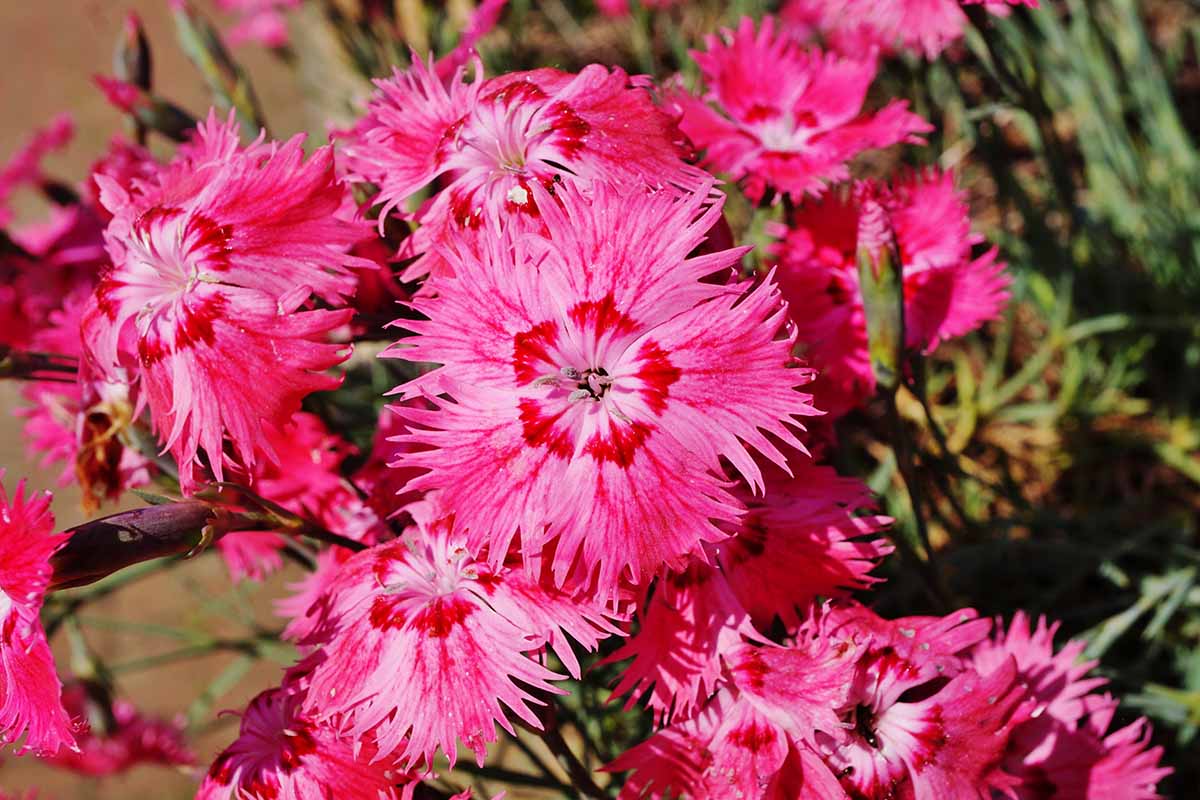
Superb in rockeries and traditional garden settings, be sure to plant plenty where you can enjoy their captivating colors and fragrance, flanking benches, entryways, paths, and patios.
And they’re wonderful in floral arrangements, so plant extras for cutting!
Do you have a sweet spot for Cheddar pinks? Tell us about it in the comments section below.
And for more information about growing dianthus, be sure to read these guides next:
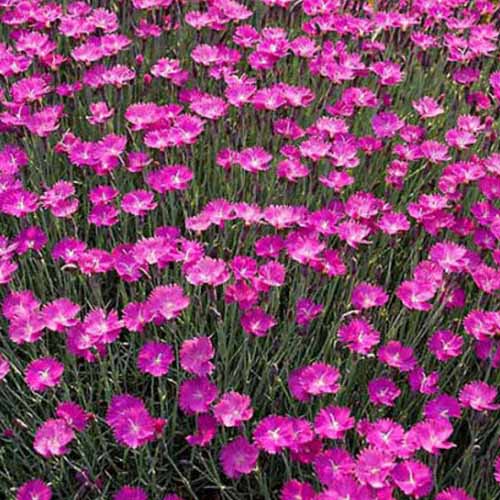

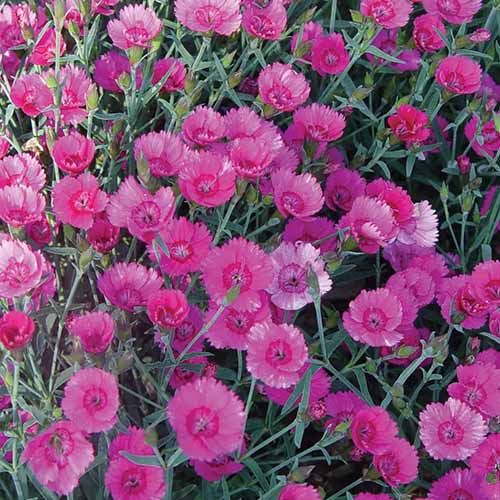
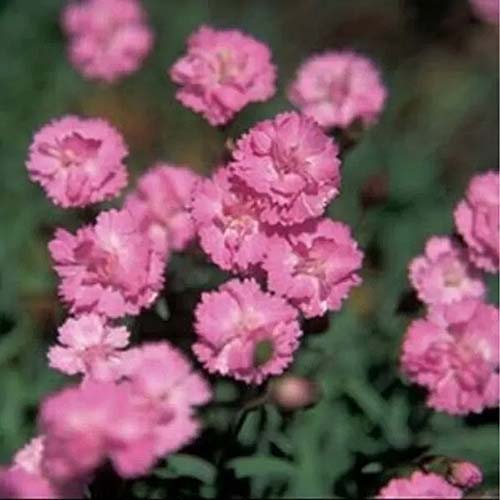


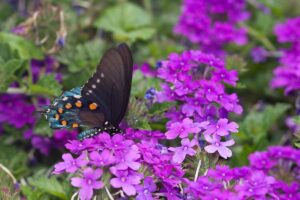

Love that this variety of dianthus smells like cloves and its two-tone pink color. We haven’t grown this variety of dianthus yet, but I will definitely be adding it to my list for next year. Thank you for the great article!